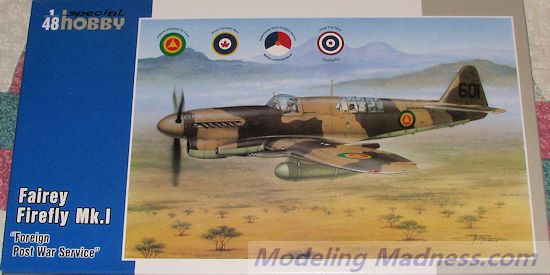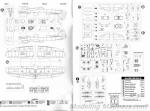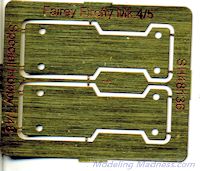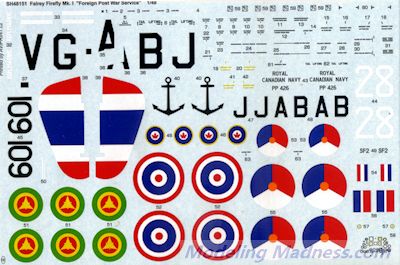
Special Hobby 1/48 Firefly Mk.I 'Foreign Postwar Service'
| KIT #: | SH 48151 |
| PRICE: | $57.00 SRP |
| DECALS: | Four options |
| REVIEWER: | Scott Van Aken |
| NOTES: | Includes resin and photo etch parts |

| HISTORY |
The Fairey Firefly was a British Second World War-era carrier-borne fighter aircraft and anti-submarine aircraft of the Fleet Air Arm (FAA).
It was superior in performance and firepower to its predecessor, the Fulmar, but only entered operational service towards the end of the war. Designed around the contemporary FAA concept of a two-seat fleet reconnaissance/fighter, the pilot and navigator/weapons officer were housed in separate stations. The design proved to be sturdy, long-ranging and docile in carrier operations, although the limitations of a single engine in a heavy airframe reduced overall performance.
The Fairey Firefly served in the Second World War as a fleet fighter but in postwar service, although it was superseded by more modern jet aircraft, the Firefly was adapted to other roles, including strike operations and anti-submarine warfare, remaining a mainstay of the FAA until the mid-1950s. Both the UK and Australia Fireflies flew ground attack operations off various aircraft carriers in the Korean War. In foreign service, the type was in operation with the naval air arms of Australia, Canada, India, and the Netherlands whose Fireflies carried out a few attack sorties as late as 1962 in Dutch New Guinea.
| THE KIT |
 The
folks at Special Hobby have done FAA fans a real favor by producing this
particular kit. The previous kit in this scale by Grand Phoenix was, from all
accounts, quite fiddly to build and relied heavily on photo etch and resin for
all the detail stuff. There are several boxings of this kit and I chose the post
war version because I like the less than usual schemes these sorts of boxings
provide.
The
folks at Special Hobby have done FAA fans a real favor by producing this
particular kit. The previous kit in this scale by Grand Phoenix was, from all
accounts, quite fiddly to build and relied heavily on photo etch and resin for
all the detail stuff. There are several boxings of this kit and I chose the post
war version because I like the less than usual schemes these sorts of boxings
provide.
The kit itself is quite typical of MPM/Special Hobby
etc in that it has nicely en graved
surface detail, no alignment pins and uses some photo etch and resin. Let me
start off with that. The photo etch fret is small with two pieces, both of them
used for the wing mounting of the rocket rails. If you don't use the rails, you
won't need these pieces. The resin is a full wheel well along with the two
engine exhaust sections and two lower engine intake pieces. As usual with the
CMK family of products, the resin is excellent.
graved
surface detail, no alignment pins and uses some photo etch and resin. Let me
start off with that. The photo etch fret is small with two pieces, both of them
used for the wing mounting of the rocket rails. If you don't use the rails, you
won't need these pieces. The resin is a full wheel well along with the two
engine exhaust sections and two lower engine intake pieces. As usual with the
CMK family of products, the resin is excellent.
The interior sections are very nicely detailed. There is inner wall framing and all the various small panels and other bits that you'd find in a operational plane; all of it done with injected plastic. Really all that is needed are seat harnesses. The radio operator/observer's station is complete with radio equipment and navigational stuff. There is a decal for the main instrument panel, which is just fine with me, or you can detail the raised area.
The wing is a constant lower wing with two upper wing halves. This will help maintain the diheadral. Tailplanes are two pieces per side and slot into the rear fuselage. Gone are the days when everything was a butt join. There are clear wing tip formation light lenses and the kit's prop has separate blades which have shallow keys.
Landing gear is nicely done with wheels in two halves as well as the oleo scissors. Also in two sections is the tail hook. I'm not sure if this would have equpped the Ethiopian or Thai version. For things under wings, you have the ability to install a pair of double rocket rails under each wing and there is also a radar pod on the centerline. This is only applicable for the Canadian option. The clear bits are nicely done, though a tad thick compared to some.
The kit has a bunch of 'do not use' parts including rockets, forward canopy, prop blades, wheels, wing tanks and so on. I have a feeling that many of these parts are for the later Mk V version.
 Instructions
are well done and in a booklet. All the 'this part goes here' lines are in red
and the overall camo schemes and two pages of adverts are in full color. Paint
information is Gunze. Four markings options are provided. One is the box art
plane from Ethiopia in sand/earth over sky (in fact, all the options have a sky
underside). The Dutch option has dark slate grey and extra dark sea grey upper
surfaces with a very low demarcation line. The Canadian plane has extra dark sea
grey for the upper color and a high demarcation line. Finally, the Thai version
is the same as the Canadian scheme and with the large red, white, blue rudder
stripes and a red spinner. The large decal sheet is very nicely printed by
Aviagraphics. In all, it will be difficult to choose which scheme to use as they
are all very nice.
Instructions
are well done and in a booklet. All the 'this part goes here' lines are in red
and the overall camo schemes and two pages of adverts are in full color. Paint
information is Gunze. Four markings options are provided. One is the box art
plane from Ethiopia in sand/earth over sky (in fact, all the options have a sky
underside). The Dutch option has dark slate grey and extra dark sea grey upper
surfaces with a very low demarcation line. The Canadian plane has extra dark sea
grey for the upper color and a high demarcation line. Finally, the Thai version
is the same as the Canadian scheme and with the large red, white, blue rudder
stripes and a red spinner. The large decal sheet is very nicely printed by
Aviagraphics. In all, it will be difficult to choose which scheme to use as they
are all very nice.
| CONCLUSIONS |
For those who wanted a 1/48 Firefly I and either couldn't find or didn't want to deal with the fiddlyness of the GP kit, you now have a viable option. It isn't cheap as the CMK family of kits are still considered to be short run, though the high end, and so are not printed in the same quantities as, say, Revell. Still, worth the time and effort I would think.
| REFERENCES |
http://en.wikipedia.org/wiki/Fairey_Firefly_I
June 2014 Thanks to me for picking
this one up on sale. If you would like your product reviewed fairly and
fairly quickly, please
contact
the editor
or see other details in the
Note to
Contributors.